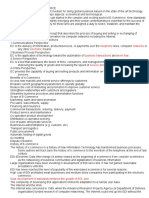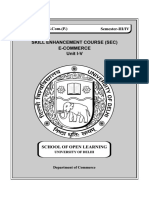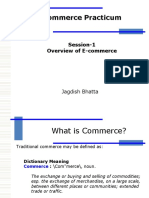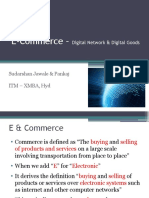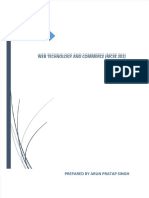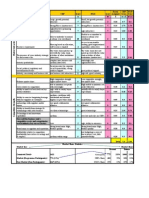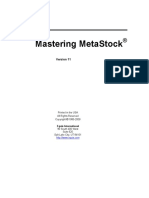Sample E Commerce File
Uploaded by
neev19Sample E Commerce File
Uploaded by
neev19PROJECT REPORT ON
E_COMMERECE
Submitted in Partial Fulfillment of the requirement of degree in Master of Business Administration Batch: 2008-2010
Submitted To: ANUBHAV LUTHRA LECTURER
Submitted By: ARIF ALI KHAN MBA 4th SEM C0560020 SDIMT
SHEELA DEVI INSTITUTE OF MANAGEMENT AND TECHNOLOGY, FARIDABAD
E-COMMERCE
INTRODUCTION TO E-COMMERCE Internet has become an important medium for doing global business based on the state of the art technology. Electronic commerce has two major aspects: economical and technological. The stress of this course will show you how to get started in the complex and exciting world of Electronic Commerce. New standards and new facilities are constantly emerging and their proper understanding is essential for the success of an operation, and especially for those who are assigned a duty to select, establish, and maintain the necessary infrastructure. What is e-Commerce? E-commerce is an emerging concept that describes the process of buying and selling or exchanging of products, services, and information via computer networks including the internet. Definition of E-Commerce from Different Perspective 1. Communications Perspective EC is the delivery of information, products/services, or payments over the telephone lines, computer networks or any other electronic means. 2. Business Process Perspective EC is the application of technology toward the automation of business transaction sand work flow. 3. Service Perspective EC is a tool that addresses the desire of firms, consumers, and management to cut service costs while improving the quality of goods and increasing the speed of service delivery.
4. Online Perspective EC provides the capability of buying grand selling products and information on the internet and other online Advantages of e-Commerce Access new markets and extend service offerings to customers Broaden current geographical parameters to operate globally Reduce the cost of marketing and promotion Improve customer service Strengthen relationships with customers and suppliers Streamline business processes and administrative functions
Business Applications Marketing, sales and sales promotion Pre-sales, subcontracts, supply Financing and insurance Commercial transactions: ordering, delivery, payment Product service and maintenance Co-operative product development Distributed co-operative working Use of public and private services Business-to-administrations (e.g. customs, etc) Transport and logistics Public procurement Automatic trading of digital goods Accounting Dispute resolution
History of E-commerce The history of e commerce is a history of how Information Technology has transformed business processes. Some authors will track back the history of e commerce to the invention of the telephone at the end of last century. EDI (Electronic Data Interchange) is widely viewed as the beginning of ecommerce if we consider ecommerce as the networking of business communities and digitalization of business information. Large organizations have been investing in development of EDI since sixties. It has not gained reasonable acceptance until eighties. EDI has never reached the level of popularity of the Web-based ecommerce for several reasons: High cost of EDI prohibited small businesses and medium-sized companies from participating in the electronic commerce; Slow development of standards hindered the growth of EDI; and The complexity of developing EDI applications limited its adaptation to a narrow user base. The Internet and the Web The Internet was conceived in 1969, when the Advanced Research Projects Agency (a Department of Defense organization) funded research of computer networking. The Internet could end up like EDI without the emergence of the World Wide Web in 1990s. The Web became a popular mainstream medium (perceived as the fourth mainstream medium in addition to print, radio and TV) in a speed which had never been seen before. The Web users and content were almost doubled every a couple of months in 1995 and 1996. The web and telecommunication technology had fueled the stock bubble in the roaring 90s and eventually pushed NASDAQ
over 5,000 in 2000 before it crashed down to 1,200 in 2002. XML and Web Services Besides the availability of technical infrastructures, the popularity of the Web is largely attributed to the low cost of access and simplicity of HTML authoring, which are the obstacles of EDI development. The Internet and the Web have overcome the technical difficulty of EDI, but it has not solved the problem of slow development of e commerce standards. XML, as a meta markup language, provides a development tool for defining format of data interchange in a wide variety of business communities. Web Services offers a flexible and effective architecture for the implementation. There is no doubt that XML and the Web Services will shape the course of e commerce in years to come.
Concepts of Electronic Commerce Electronic commerce is narrowly defined as buying and selling products/services over the Internet. The concept has been broadened to include all business activities of a sales cycle. The distinction between Ecommerce and E-business has become blurred. Ecommerce and Electronic Commerce has been used interchangeably, Electronic Business, however, has not been a widely accepted terminology. David Kosiur described the Components of Electronic Commerce in three dimensions (Processes, Institutions and Networks) in his 1997 book Understanding Electronic Commerce. We expand Institutions as E-commerce Players, Networks as Technologies and add Markets as the fourth dimension of E-commerce. E- Commerce In Action How e-Commerce Works The consumer first moves through the internet to the merchants web site. At the web site, the consumer is briefly given an introduction to the product or services the merchant offers. It is at this point that the consumer makes
the decision to visit the web store by clicking on a link or button located on the web page (e.g., Buy Now, Shop Online, or an image of a shopping cart button are common entry points into a web store). After choosing to visit the web store, the consumer is typically connected to an online transaction server located somewhere else on the internet which runs software commonly referred to as a shopping cart application. The shopping cart application has been setup by the merchant to display all products and services offered, as well as calculate pricing, taxes, shipping charges, etc. From there, the consumer decides that he wants to purchase something, so he enters all pertinent credit card information and a sales order is produced. Depending on the ecommerce implementation, the sales order can now take two totally different paths for confirming to the consumer that the order is officially placed. Scenario 1 The consumers credit card information goes directly through a private gateway to a processing network, where the issuing and acquiring banks complete or deny the transaction. This generally takes place in no more than 5-7 seconds and the consumer is then informed that the order was received, the credit card was authorized, and that the product will ultimately be shipped. Scenario 2 The consumers entire order and credit card information is
electronically submitted back to the merchants server (usually via email, FTP, or SSL connection) where the order can be reviewed first and then approved for credit card authorization through a processing network. The consumer then receives an email shortly afterwards, confirming the order being received, the credit card being authorized, and status on when the
product will exactly be shipped. In both scenarios, the process is transparent to the consumer and appears virtually the same. However, the first scenario is a more simplistic method of setting up a shopping cart application and does not take into consideration any back office issues that may delay shipment (i.e., items out of stock, back orders, orders submitted after office hours or during holidays, etc.). ManageMores ecommerce Manager relies on the second scenario to handle all of its ecommerce orders. This second scenario keeps the consumer accurately informed throughout the entire ordering process. For the sake of this tutorial, we will assume an ecommerce implementation that uses the second scenario mentioned above. There are several basic steps you will need to accomplish before becoming Commerce Enabled. Getting a Merchant Bank Account Web Hosting Web Design Considerations Registering a Domain Name Obtaining a Digital Certificate
Let us review each step in more detail below:
Getting a Merchant Bank Account In order to be able to accept credit cards, you must apply for an account with a credit card merchant account provider. This can be relatively easy or somewhat difficult, depending on which country you live in, and the type of business you are running. In the past, many businesses would sign up for credit card processing through their own commercial banking institutions. However, the internet has now made it simple to shop around for the best credit card discount rates from an endless amount of merchant account
providers worldwide. A simple web search on credit card processor should be enough to get you started. Depending on how you process credit cards (especially if you plan on using Scenario 1 from the introduction), you may need to find a merchant account provider that specializes in internet payment transactions. When choosing a merchant account provider, the following should also be noted: In order for credit card authorization to be automatic from within ManageMore, you must ensure that your merchant account provider has credit card processors that connect with IC Verify, PC Charge, or AuthorizeNet (i.e. Intellicharge Interface) software. These products are sold separately from ManageMore and eliminate the need for merchant terminal devices or separate time consuming steps to approve credit cards. Your merchant account provider must allow you to handle non-swiped credit card transactions. This refers to transactions where the customer is not present and only the credit card number and expiration date are being used for approving the charges. When choosing a merchant account provider, you should do a little research on the companys reputation, years in business, and company size. Constantly changing to a new merchant account provider when your old one goes out-of business can be costly and time consuming. Avoid merchant account providers that ask for a nonrefundable fee before you get approved. Avoid merchant account providers that require 1 or 2 year contract terms. Since there are so many merchant account providers available, it
doesnt make sense to lock your company into a commitment for any period of time. Expect merchant account providers to have some form of a sign up fee after being approved only. These fees can come in the form of an application fee, processing fee, software fee, etc. Typically expect to pay around $100 to $500 for getting an account setup to accept credit cards and sometimes electronic checks. You should be able to find a merchant account provider that can offer you discount credit cards rates ranging from 1.75% to 2.75% and no more than .25 cent per transaction. If not, contact Intellisoft regarding our merchant account provider affiliates and the free Intellicharge Interface just for signing up with them. You will need a dedicated phone line or data line for processing credit cards and electronic checks. Note: If your computer or local area network is already connected to the internet, a separate data line will not be necessary if you use the Intellicharge Interface for electronic payment. Web Hosting Web hosting is a very important step in this process, as this is how you gain a presence on the internet in the first place. There are actually two scenarios that can be used for web hosting. Scenario1 involves setting up and maintaining your own web server, while Scenario 2 involves farming out all web hosting administration to an ISP. (Scenario 1 will not be discussed further in this article as it pertains to larger organizations which are not concerned with the high expense of running their own web server, hiring permanent IT staff, dealing with security, etc.)An Internet Service Provider (ISP) is a company that provides you with internet access and limited hard drive space on their web servers for hosting your web site. You will need to setup an account for internet access with the ISP of your choice.
The following should be noted when searching for an Internet Service Provider: Always try to find an ISP that can provide a local telephone number for you to connect to the internet. Choose an ISP that is known for having few interruptions of service. Choose an ISP that is known for good technical support and has knowledgeable people familiar with ecommerce sites. choose an ISP that consistently has fast connection speeds.As with any company you do business with, make sure the ISP is reputable. Now, here is the part that gets a bit tricky to understand. The online transaction providers that offer the actual web store itself can sometimes be hosted by your same ISP or may require a completely different provider, referred to as a Commerce Service Provider (CSP). Many small businesses tend to choose CSPs for creating a web store because it gives them the flexibility of choosing a provider that offers competitive pricing and the best shopping cart application for their needs. Online transaction providers will usually provide one shopping cart solution they feel is better than the many others that exist and differ by price, appearance, layout, functionality, and ease of use. The following should be noted when dealing with shopping cart applications: Online transaction providers will either sell or rent you the use of an online shopping cart application for your business. Be forewarned that purchasing an online shopping cart application is very expensive. Most businesses will rent these online web store programs rather than committing to such a steep investment.
Rental pricing for the use of shopping cart programs vary depending on number of transactions generated a month, number of products listed on the shopping cart application, and the sophistication of the shopping cart application itself.
There are a lot of online transaction providers out there, and they all have varying packages. Deciding on a providers package that fits your needs is perhaps the most important aspect. In the case of ManageMore, the eCommerce Manager module was designed to work with specific shopping cart applications for proper retrieval and processing of web orders.
Web Design Considerations With little knowledge of HTML and a lot of patience, you can probably create your own corporate web site with the help of products like Microsoft FrontPage or DreamWeaver. However, when adding a web store to your web site, you may want to seek the help of professional web designers to make the look and feel of your web store consistent with the rest of your corporate web site. Most shopping cart applications, like nSoftCart by Mercantec, allow its templates to be modified just for this purpose. In many cases, the same ISP or CSP you choose can provide web design and consultation.
Registering a Domain Name If your business already has a corporate web site implemented, then you probably already have a domain name and dont need to read this section.Domain names are the names for computers on the Internet that
correspond to IP (Internet protocol) numbers to route information to addresses on the Internet network. Domain names serve as a convenient way of locating information and people on the Internet. In layman terms, will it be important to you, for customers to find your web site by typing 123.123.456.456 or by typing somethingsimple to remember like www.mybiz.com? Registering a domain name is one of the most important decisions you can make for your online identity. Your domain name says who you are to your clients, your peers - the whole world. The basics for registering a domain name are:1. Contact a domain name registrar on the internet to register for a domain name. There are many to choose from, just do a web search on domain name registrar to get you started. 2. Select a unique domain name you would like others to use for finding your web site. One place to go for checking availability of a domain name is www.whois.net3. Expect a registration fee of $10 - $100 annually for the central registrar to keep your domain name active on the internet.There are many other questions that arise when considering a domain name for your business that go outside the scope of this tutorial
Obtaining a Digital Certificate A digital certificate, also known as a SSL Server Certificate, enables SSL (Secure Socket Layer encryption) on the web server. SSL protects communications so you can take credit card orders securely and ensure that hackers cannot eavesdrop on you. Any ecommerce company that provides you with an online web store will require you to have SSL before you can use their services. Thankfully, for most people obtaining a digital
certificate is not a problem. For a minimal fee one can usually use the certificate owned by the web hosting company where your page resides. If you are a larger company, however, you may want to get your own digital certificate. A certificate costs about $125.00 and can be obtained from Thawte or Verisign.
Electronic Payment Systems Electronic payment is an integral part of electronic commerce. Broadly defined, electronic payment is a financial exchange that takes place online between buyers and sellers. The content of this exchange is usually some form of digital financial instrument (such as encrypted credit card numbers, electronic checks, or digital cash) that is backed by a bank or an intermediary, or by legal tender. Three factors are stimulating interest among financial institutions in electronic payments: decreasing technology costs, reduced operational and processing costs, and increasing online commerce. The desire to reduce costs is one major reason for the increase in elec-tronic payments. Cash and checks are very expensive to process, and banks are seeking less costly alternatives. It is estimated that approximately 56 percent of consumer transactions in the United States are cash and 29 per-cent are check. Credits, debits, and other electronic transactions account for about 15 percent of all consumer transactions, and are expected to increase rapidly. Electronic transactions numbered 33 billion in 1993 and are ex-pected to climb to 118 billion by the year 2000. For the same period, paper transactions are forecast to show very modest growth, from 117 billion in 1993 to 135 billion in the year 2000. Banks and retailers want to wean customers away from paper transactions because the processing overhead is both labour intensive and costly.
The crucial issue in electronic commerce revolves around how consumers will pay businesses online for various products and services. Currently, consumers can view an endless variety of products and services offered by vendors on the Internet, but a consistent and secure payment capability does not exist. The solutions proposed to the online payment problem have been ad hoc at best. For instance, in one method marketed by Cyber Cash, users install client software packages, sometimes known as electronic wallets, on their browsers. This software then communicates with electronic cash registers that run on merchants Web servers. Each vendors client works with only that vendors own server software, a rather restrictive scenario. Currently, merchants face the unappealing option of either picking one standard and alienating consumers not subscribing to a standard or needing to support multiple standards, which entails extra time, effort, and money. Today, the proliferation of incompatible electronic payment schemes has stifled electronic commerce in much the same way the split between Beta and VHS standards stifled the video industrys growth in the 1970s. Banks faced similar problems in off-line commerce in the early nineteenth century. Many banks issued their own notes, and a recurrent problem was the tendency of some institutions to issue more notes than they had gold as back-ing. Further, getting one bank to honor anothers notes was a major problem. Innovations in payment methods involved the creation of new financial instruments that relied on backing from governments or central banks, and gradually came to be used as money. Banks are solving these problems all over again in an online environment. The goal of online commerce is to develop a small set of payment methods that are widely used by consumers and widely accepted by merchants and banks.
Overview of the Electronic Payment Technology Electronic payments first emerged with the development of wire transfers. Early wire transfer services such as Western Union enabled an individual to deliver currency to a clerk at one location, who then instructed a clerk at another location to disburse funds to a party at that second location who was able to identify himself as the intended recipient. Cash was delivered to the customer only after identity was established. In this scenario, there was no banking environment; Western Union was a telegraph company. Assurance of payment relied on the financial stability of the firm. Security was provided to the extent that Western Union was a privately controlled transmission facility used to send messages about funds transfer; its lines were not shared with the public, and transactions were private. Authentication was provided only by a signature at the other end of the transmission that verified that the intended party had indeed received the funds. During the 1960s and early 1970s, private networking technology has enabled the development of alternative electronic funds transfer (EFT) systems. Electronic funds transfer systems have shortened the time of payment instruction transfer between banks, and in the process have reduced float. However, EFT systems have not changed the fundamental structure of the payment system. Many of the so-called payment innovations over the past two decades have been aimed at minimizing banking costs such as reserve requirements, speeding up check clearing, and minimizing fraud. However, the consumer rarely interacted with the early EFT systems. Recent innovations in electronic commerce aim to affect the way consumers deal with payments and appear to be in the direction of a real-time electronic trans-mission, clearing, and settlement system.
Consumer electronic payment systems are growing rapidly, but the opportunities are scarcely tapped. In the United States, it is estimated that only 3 percent of the $460 billion supermarket industry is transacted on credit or debit cards. Only 1 percent of the $300 billion professional services area is transacted electronically. Less than 12 percent of business at gasoline service stations is electronic and less than 1 percent of fast food restaurants have magstripe readers. The educational market alone is more than $100 billion today, only 6 percent of which is transacted electronically. Even more important is the predicted growth ahead. Consumer payments at the point of sale were $3.6 trillion in 1994, 19 percent of which was on credit and debit cards [F09S]. Recently, several innovations helped to simplify consumer payments. These include: Innovations Affecting Consumers: Credit and debit cards, automated teller machines (ATMs), stored-value cards, and electronic banking. Innovations cards. Innovations Affecting Companies: The payment mechanisms that banks provide to corporate customers, such as interbank transfers through automated clearing houses (ACHs) that allow companies to pay workers by direct deposits. Enabling Online Commerce: Digital cash, electronic checks, smart cards (also called electronic purses), and encrypted credit
Electronic or Digital Cash Electronic or digital cash combines computerized convenience with security and privacy that improve on paper cash. The versatility of
digital cash opens up a host of new markets and applications. Digital cash attempts to replace paper cash as the principal payment vehicle in online payments. Although it may be surprising to some, even after thirty years of developments in electronic payment systems, cash is still the most prevalent consumer payment instrument. Cash remains the dominant form of payment for three reasons: lack of consumer trust in the banking system; inefficient clearing and settlement of non cash transactions; and negative real interest rates on bank deposits. These reasons behind the prevalent use of cash in business transactions indicate the need to re-engineer purchasing processes. In order to displace cash, electronic payment systems need to have some cash-like qualities that current credit and debit cards lack. For example, cash is negotiable, meaning that it can be given or traded to someone else. Cash is legal tender, meaning that the payee is obligated to take it. Cash is a bearer instrument, meaning that possession is proof of ownership. Cash can be held and used by anyone, even those without a bank account. Finally, cash places no risk on the part of the acceptor; the medium is always good.In comparison to cash, debit and credit cards have a number of limitations. First, credit and debit cards cannot be given away because, technically, they are identification cards owned by the issuer and restricted to one user. Credit and debit cards are not legal tender, given that merchants have the right to refuse to accept them. Nor are credit and debit cards bearer instruments; their usage requires an account relationship and authorization system. Similarly, checks require either personal knowledge of the payer, or a check guarantee system. A really novel electronic payment method needs to do more than recreate the convenience that is offered by credit and debit cards.
Electronic Funds Transfer Electronic Funds Transfer is used to settle credit card transactions by transferring funds between the seller and the bank, which has issued the credit card to the customer. A Clearing House would settle the accounts of the sending bank and the receiving bank. Online Catalogs Online catalogs provide easy access to product information. Consumers are benefited because they are able to obtain detailed, up to the minute information about a wide range of products over the Internet, without having to endure the inconvenience of visiting a showroom. For assisted selling, a valuable tool is a marketing encyclopedia, an intelligent electron a companys most current product and service information. It provides a single point of entry for harnessing and distributing all product information. Product managers can update information in the database and immediately broadcast the changes throughout the enterprise. Some critical requirements of any marketing encyclopedia are the ability to easily create and maintain a repository of product information; the ability to create multiple search mechanisms to assist in locating information; and the ability to alert sales representatives and customers to bundled products and services, promotions, and complementary products.
Intelligent Agents The Intelligent agent is software that assists people and acts on their behalf. Intelligent agents work by allowing people to delegate work that they could have done, to the agent software. Agents can, just as assistants can, automate repetitive tasks, remember things the user might have forgotten, intelligently summarize complex data, learn from the user and even make recommendations to the user. In addition to making recommendations to the user, the agents can also make decisions and perform actions based on those decisions. One typical use of the intelligent agent may be found in the exploration of data on the Internet. The Internet can be viewed as a large distributed Information resource, with connecting systems that are designed and implemented by many different organizations with various goals and agendas. The growth of the Internet and correspondingly the vast amount of Information it holds, presents a problem to the users-information overload. This causes a problem of locating the relevant information. As a result much of the information is discarded and processed in a sub optimal manner. The agent technology may help the user by helping the user get around this problem. In times to come it is hoped that agent technology can enhance the feature of electronic commerce by efficiently matching buyers and sellers.
PayPal PayPal is an e-commerce business allowing payments and money transfers to be made through the Internet. It serves as an electronic alternative to traditional paper methods such as cheques and money orders. PayPal performs payment processing for online vendors, auction sites, and other corporate users, for which it charges a fee. It sometimes also charges a transaction fee for receiving money (a percentage of the amount sent plus an additional fixed amount). The fees charged depend on the currency used, the payment option used, the country of the sender, the country of the recipient, the amount sent and the recipient's account type. On October 3, 2002, PayPal became a wholly owned subsidiary of eBay. Its corporate headquarters are in San Jose, California, United States at eBay's North First Street satellite office campus
Debit card A Debit card is a plastic card which provides an alternative payment method to cash when making purchases. Its functionality is more similar to writing a cheque as the funds are withdrawn directly from either the bank account (often referred to as a cheque card), or from the remaining balance on the card. In some cases, the cards are designed exclusively for use on the Internet, and so there is no physical card.[1][2] In potential cases, the card may be completely different compared to these two examples. The use of debit cards has become wide-spread in many countries and has overtaken the cheque, and in some instances cash transactions by volume. Like credit cards, debit cards are used widely for telephone and Internet purchases. This may cause inconvenient delays at peak shopping times
(e.g., the last shopping day before Christmas), caused when the volume of transactions overloads the bank networks. In some countries the debit card is multipurpose, acting as the ATM card for withdrawing cash and as a cheque guarantee card. Merchants can also offer "cashback"/"cashout" facilities to customers, where a customer can withdraw cash along with their purchase. Credit Card A credit card is a system of payment named after the small plastic card issued to users of the system. In the case of credit cards, the issuer lends money to the consumer (or the user) to be paid later to the merchant. It is different from a charge card, which requires the balance to be paid in full each month. In contrast, a credit card allows the consumer to 'revolve' their balance, at the cost of having interest charged. Most credit cards are issued by local banks or Credit Unions, and are the same shape and size, as specified by the ISO 7810 standard. Smart Card A smart card, chip card, or integrated circuit card (ICC), is defined as any pocket-sized card with embedded integrated circuits which can process information. This implies that it can receive input which is processed - by way of the ICC applications - and delivered as an output. There are two broad categories of ICCs. Memory cards contain only non-volatile memory storage components, and perhaps some specific security logic. Microprocessor cards contain volatile memory and microprocessor components. The card is made of plastic, generally PVC, but sometimes ABS. Characterstics
Dimensions are normally credit card size. The ID-1 of ISO/IEC 7810 standard defines them as 85.60 53.98 mm. Another popular size is ID000 which is 25 x 15 mm. Both are .76 mm thick.
Contains a security system - tamper-resistant properties (e.g. a secure cryptoprocessor, secure file system, human-readable features) and is capable of providing security services (e.g. confidentiality of information in the memory).
Asset managed by way of a central administration system which interchanges information and configuration settings with the card through the security system. The latter includes card hotlisting, updates for application data. Card data is transferred to the central administration system through card
reading devices, such as ticket readers, ATMs etc.
Benefits Smart cards provide a means of effecting business transactions in a flexible, secure, standard way with minimal human intervention VeriSign VeriSign, Inc. (NASDAQ: VRSN
You might also like
- Ecommerce: E-Commerce Is The Activity of Buying or Selling of Products On Online Services orNo ratings yetEcommerce: E-Commerce Is The Activity of Buying or Selling of Products On Online Services or47 pages
- Database in Electronic Commerce - 112540No ratings yetDatabase in Electronic Commerce - 11254019 pages
- E-Commerce Important Questions (7 Files Merged)No ratings yetE-Commerce Important Questions (7 Files Merged)110 pages
- E-commerce-Evaluation of Marketing EffortsNo ratings yetE-commerce-Evaluation of Marketing Efforts19 pages
- E Commerce and Its Technological Aspects - Chapter 1No ratings yetE Commerce and Its Technological Aspects - Chapter 116 pages
- E-Commerce - : Sudarshan Jawale & Pankaj Itm - Xmba, HydNo ratings yetE-Commerce - : Sudarshan Jawale & Pankaj Itm - Xmba, Hyd38 pages
- Dokumen - Tips Web Technology and Commerce Unit 3 by Arun Pratap SinghNo ratings yetDokumen - Tips Web Technology and Commerce Unit 3 by Arun Pratap Singh32 pages
- Web Technology and Commerce Unit-3 by Arun Pratap SinghNo ratings yetWeb Technology and Commerce Unit-3 by Arun Pratap Singh32 pages
- Safe E-Commerce in The Private Sector Enterprises in East EuropeNo ratings yetSafe E-Commerce in The Private Sector Enterprises in East Europe49 pages
- Project File OF E-Commerce ON Commercialization of E-CommerceNo ratings yetProject File OF E-Commerce ON Commercialization of E-Commerce23 pages
- 2019 PMP Exam Questions - Sample PMP Exam Questions & Rationales100% (3)2019 PMP Exam Questions - Sample PMP Exam Questions & Rationales12 pages
- Coromandel International LTD Result Update - Q4FY12No ratings yetCoromandel International LTD Result Update - Q4FY124 pages
- A Study of Consumer Preference For Prefume & Deodorant Brands Available in Ghazipur City100% (1)A Study of Consumer Preference For Prefume & Deodorant Brands Available in Ghazipur City26 pages
- SBI Bank: ACCOUNT NO: - 872 BALANCE: - 21886.64No ratings yetSBI Bank: ACCOUNT NO: - 872 BALANCE: - 21886.6411 pages
- KCPL - Kanpur Confectioneries Private Limited (A) - Case StudyNo ratings yetKCPL - Kanpur Confectioneries Private Limited (A) - Case Study4 pages



